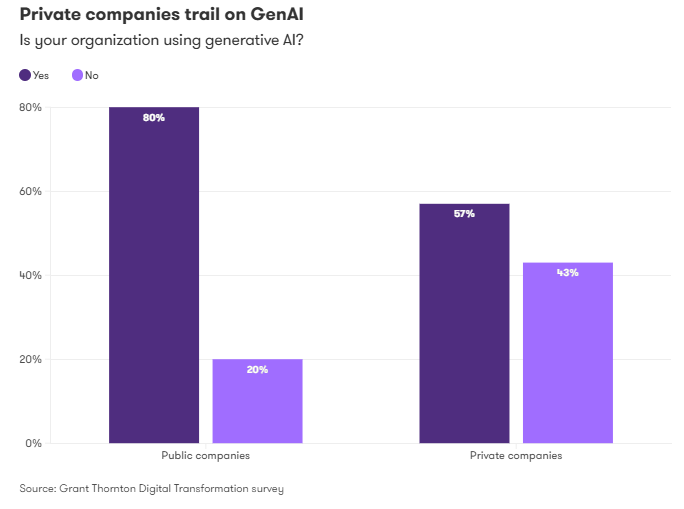GenAI to ROI

Author
Put your people in position to drive AI success
The 57% of private companies that have adopted generative AI lags far behind the 80% of public company adopters, according to Grant Thornton’s Digital Transformation Survey, which polled more than 550 executives on their technology adoption initiatives and plans.
Private companies are struggling with a new reality, as customer strategies that worked in the past are no longer driving revenue. Customers now expect goods and services that are highly personalized, and many resource-constrained private companies haven’t invested in the generative AI technology that enables customization.
This gap puts private companies at a disadvantage as competitors use GenAI to enhance customer experiences and pursue new revenue opportunities. But the good news is that GenAI adoption doesn’t require a massive upfront investment or organizationwide change management activities. A phased, practical approach to GenAI can deliver fast returns and build momentum for deeper technology enablement.
Our survey shows that despite trailing in GenAI adoption, private companies seem to understand the importance of tech, as they are slightly more likely to be increasing their technology spending this year than public companies. More than one-third (37%) of private companies plan to increase their technology spending by at least 11% this year, compared with 23% of public companies.
“We believe it is critical for us to overhaul ourselves digitally for the future if we intend to survive,” a chief strategy officer said in the survey. “Digital competency is business competency.”
The impetus for change is real. Fortunately for private companies, it’s easy to use that technology enthusiasm as a catalyst for GenAI initiatives. With small, focused use cases, it’s possible to make incremental investments in GenAI and generate quick wins that fund larger projects.
“Private companies don’t need massive scale to get GenAI right,” said Grant Thornton Technology Modernization Principal Tony Dinola. “GenAI can be used easily and effectively in any enterprise to automate the creation of content such as job descriptions, accounting memos, and sales and marketing flyers. Identify those use cases and leverage the technology to reduce the time required to develop the content.”

From GenAI to growth: A smart path for private companies
GenAI initiatives for private companies can start with simple approaches.
Our survey shows that two of the most common uses for GenAI are data analytics/business intelligence and customer relationship management. Data analytics and business intelligence use cases can include:
- Generating easy-to-understand summaries of sales dashboards or financial reports for various stakeholders
- Predicting future performance based on historical data and/or “what-if” scenario planning
- Analyzing customer reviews and customer support requests to identify areas where the business can improve
For customer-facing purposes, many companies are using GenAI to:
- Provide customer support with chatbots that answer FAQs and track orders
- Generate invoices, reports and even contracts based on standard templates
- Assist with appointment reminders and follow-up messages.
A chief strategy officer at a private technology company responding to our survey said they are using AI agents to both enhance strategic decision-making and improve customer engagement.
“As more data becomes accessible and systems become more interconnected, I see a shift towards real-time insights and more personalized experiences,” they said.
The easiest way to begin GenAI adoption is by identifying business processes and problems and considering how (and whether) GenAI can help. Top targets for GenAI fixes are processes that are highly repetitive, follow clear rules or patterns, and require a lot of human time to perform — but not much human time to verify.
Data entry, invoice processing, customer support, contract review, document generation, and inventory monitoring and management are common use cases that can be addressed with GenAI — provided the data supporting those tasks is accurate, complete, timely and consistent.
A use case that meets those criteria and is aligned with the organization’s business strategy often is a good place to start with GenAI adoption. The potential return on investment should be validated with a pilot or proof-of-concept exercise before proceeding with full adoption.
As success is achieved and momentum for GenAI improvements increases, a structured approach can be implemented to prioritize use cases and funding for additional initiatives.
Tech enablement starts with team enablement
The benefits associated with AI will only be realized by private companies whose leaders have the courage and compassion to implement the change effectively.
Courage is necessary because almost every business change encounters resistance. Leaders need to be prepared to push through that resistance to implement technology that’s going to improve their business.
Compassion is necessary because employees might be afraid that GenAI is going to replace their jobs. Answering their concerns requires consistent, transparent communication, as well as training to help them use the technology — and identify new GenAI use cases that will make them more effective and confident in their roles.
The best employee GenAI training includes:
- Aligning training goals with business outcomes
- Explaining the tenets of ethical and responsible AI use
- Undertaking a skills gap assessment to tailor training to employees’ needs
- Setting measurable learning outcomes for use of AI tools
- Providing hands-on experience, as many users learn through active use
- Creating opportunities for continuous learning
This training is the foundation for the courage and compassion that will help leaders build a culture that nurtures innovation and value creation at a time when private companies need it most.
4 tips for making tech investments count
Private company leaders have limited funds to spend on GenAI, so they need to make those investments count.
“Incorporating AI into tech enablement is a balancing act that pays off when leadership, governance and value creation move in sync,” said Mike Notarangelo, Partner and Private Equity Audit Leader for Grant Thornton.
To get the most return out of GenAI spending, private company leaders should consider the following:
Ask your customers how you can serve them. Customer data is the backbone of GenAI-based personalization. GenAI can make follow-up interactions easy. Use these opportunities to get feedback that will help you serve customers better.
Design guardrails that foster safety and agility. GenAI’s potential for growth is strongest when it is applied within guardrails that promote strong governance and risk management while allowing for enabling experimentation.
Be ready to scale up. As GenAI improvements advance, private companies need systems that support data sharing, analytics and governance. Investing in ERP and CRM upgrades that integrate GenAI is a key to long-term scalability.
Measure your progress. Customer and employee usage metrics are good initial indicators for the potential success of GenAI tools. Meanwhile, our survey shows that increased revenue, reduced operational costs and improved customer satisfaction are the most common metrics private companies are monitoring for ROI on tech investments.
Build for long-term growth
Private companies can’t afford to wait on generative AI. The risks of inaction — loss of market share and poor customer engagement — are too high.
But the path forward doesn’t have to be disruptive. By taking a step-by-step approach focused on ROI, private companies can harness GenAI now, lay the groundwork for scalable transformation, and build a future-ready business. The tools and opportunities are already in place. What low-risk, high-impact GenAI use cases could move your business forward — today?
Guiding the reader: A few follow-up ideas for effectively implementing GenAI.
- Be ready to scale with GenAI-integrated ERP/CRM systems:
Businesses should consider investing in ERP/CRM platforms or accelerating digital transformation to fully leverage GenAI capabilities. Integrating GenAI into these systems helps automate complex workflows, predict business trends, and personalize customer service - ultimately boosting operational efficiency and revenue. For example, platforms like SAP Business One, Oracle, Microsoft Dynamics 365, and Salesforce are leading the way in GenAI integration, enabling real-time data analysis, supply chain optimization, and automatic content generation such as financial reports or contracts. Implementation steps may include evaluating current data, running pilot programs, and upgrading systems to support secure data sharing. For smaller businesses, starting with lightweight ERP solutions can reduce initial costs while ensuring long-term scalability. Without timely investment, companies may face challenges such as fragmented data or limited forecasting capabilities - resulting in lost competitive advantage. - Train your workforce and foster a culture of innovation:
Employee training should be closely aligned with business goals and emphasize the ethical use of AI - such as data privacy and bias prevention. Start by assessing current skill levels to personalize training programs, provide hands-on experience with GenAI tools, and promote continuous learning to nurture a culture of creativity and adaptability. To support this effectively, companies should collaborate with specialized AI consulting firms that can guide GenAI adoption from exploration through execution. These firms offer comprehensive services, including risk assessments, ROI modeling, and tailored employee training - helping to reduce resistance and accelerate implementation. Leveraging external expertise not only helps avoid common pitfalls like data security gaps, but also fosters sustainable innovation by empowering employees to confidently use GenAI to enhance performance.
Contact us

